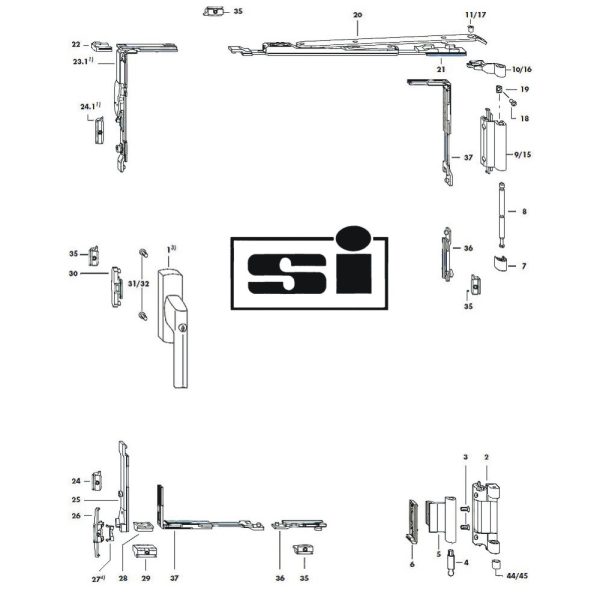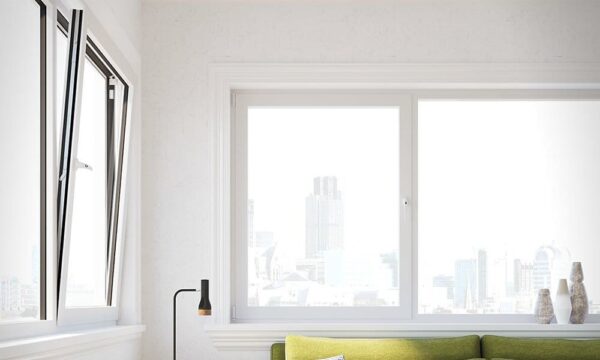Tilt and turn windows have been popular for decades in European and Scandinavian countries, but were little known in the UK due to limited suppliers and the trend for casement windows in our homes.
Today, tilt and turn windows are growing in popularity because they are significantly better than regular casement and opening out windows. As the design of homes becomes more modern with larger panes of glass and fewer mullions or transoms, tilt and turn windows provide an excellent design solution.
In this article, you will learn why tilt and turn windows could be better for your home or commercial building, how they function, where they are suitable for installation, and which brands to consider when purchasing.
What are tilt and turn windows?
Tilt and turn windows do as their name suggests. They tilt inwards and also turn inwards. This double operation is always carried out via the window handle.
It is the window gearing on a tilt and turn window that creates the double functionality, comprising of many more parts than a regular casement window.
Unlike regular windows, the tilt and turn gearing is found around the entire window opening not just the sides.

Image courtesy of Siegenia
How do you open and close tilt and turn windows and doors?
The handle is part of the ingenious mechanism for tilt and turn windows and doors:
Closed: To secure the window or door, turn the handle downwards, which firmly engages all the locking points.
Tilt: Start in the closed position, turn the handle upwards (90 degrees) and then pull it towards you to create the ventilation gap at the top. Note that the panel will tilt inwards.
Turn: Again, start in the closed position, turn the handle upwards (180 degrees) and open the same as a casement window or door hinged to the side. Note that the panel will open inwards.
This method of opening and closing a tilt and turn window is standard with most brands, but do check with your individual provider, or contact us for more information and advice.
Tilt function
Turn the handle in one direction and the glass panel tilts inwards from the bottom, creating a small gap at the top, allowing for ventilation with basic security in that nobody can enter through the window.

Turn function
From the closed position, turning the handle the other way, allows the opening vent to open inwards from the side, like a window or door.

How secure are tilt and turn windows and doors?
The opening/locking mechanism bar is across the whole length of the pane, not just at one point of the frame. This makes the multiple locking system more robust by distributing the locking force evenly and making it more difficult for the intruder to force it open. In addition, it is nearly impossible to reach in with a hand when in the tilt position due to the size of the opening.
For complete security and peace of mind, upgrade a tilt and turn window with toughened or laminated safety glass. You can also check out the tilt and turn windows and doors which have been approved Secured by Design or PAS 24 security testing. Schüco tilt and turn windows also feature and install additional security features, such as AvanTec locking systems and sensors.
Are tilt and turn windows and doors energy-efficient?
Yes. All modern windows and doors comprise thermally insulated frames and high-performance glass and are designed to be energy efficient. The choice between double or triple glazing can also impact their efficiency. As a minimum you should expect window glazed with double glazed units, having a soft-coat low-emissivity coating, warm edge spacer bars and argon gas fill.
Triple glazing creates an even more insulated window with excellent U-Values depending on the brand used.
What are tilt and turn window restrictors?
For added security and safety, you can add window restrictors with adjustable arms, which keep the window locked open as much as you want in the tilt position. This feature, as well as making your home more secure by keeping people out, is a safety feature for young children by eliminating the opening space to fall through. In addition, in case of a fire and you need an emergency exit, you can open it fully.
Are tilt and turn windows a good idea?
If you don’t mind the inward opening action, a tilt and turn window can be much better than standard open outwards windows. But their suitability also depends on your home, and the functionality you want from your windows. These windows are now the go-to product when you want bigger opening windows, no mullions or transoms and the added functionality. They are also widely used in modern homes.
Which are the best tilt and turn windows?
Tilt and turn windows and doors are available in all materials: PVCu, aluminium and timber and hybrid windows having aluminium outside and wood inside.
Here are some of our recommendation for quality tilt and turn windows:
Aluminium
- Schüco Windows – available in a wide range of tilt and turn types.
- Cortizo Cor 70 windows, with an innovative hidden handle and ultra slim design.
- Aluk Optio 58BW TBT HI Tilt-Before-Turn
- Smart Systems Alitherm 400 windows.
PVCu Windows
- Rehau Total 70
- Liniar tilt and turn windows
- Veka Halo Rustique and System 10
Hybrid and Alu-Clad Windows
- Internorm HF410
- Velfac Tilt and Turn windows
- Rationel Tilt and Turn windows
Timber Windows
- Breech
- George Barnsdale
- Timber Windows
Frequently Asked Questions about tilt and turn windows
Which is better, tilt and turn or casement windows?
Neither is better than the other, they are just have a different way of opening. Tilt and Turn windows always create bigger opening windows, can be made up to virtually the size of a door and offer an easy way to clean the outside pane of glass from inside.
Do tilt and turn windows and doors open inwards or outwards?
They are designed to only open inwards.
Are tilt and turn windows more expensive?
Tilt and turn windows cost a little more than casement windows, but it does depend on the brand and the quality.
Can I have a tilt and turn window with blinds and screen?
Yes. Tilt and turn windows can have integral blinds. Some of the more premium brands like Schüco and Interorm also provide their own integrated blind system that is significantly better then integral blinds. Flyscreens are also available if required.
Where can I find tilt and turn windows and doors near me?
If you need some help finding an installer – please get in touch with us, we will be happy to advise.
What are the disadvantages of tilt and turn windows?
These windows are not designed to be the slimmest windows so will be a little thicker than casement windows. But their functionality, quality and bigger size capability is their advantage. As these open inwards, you may not want them to interfere with curtain or blinds.






